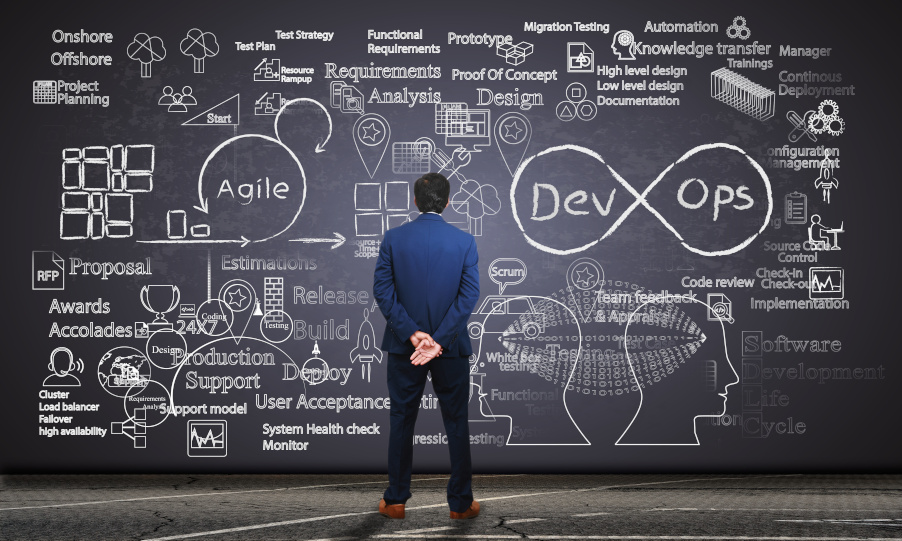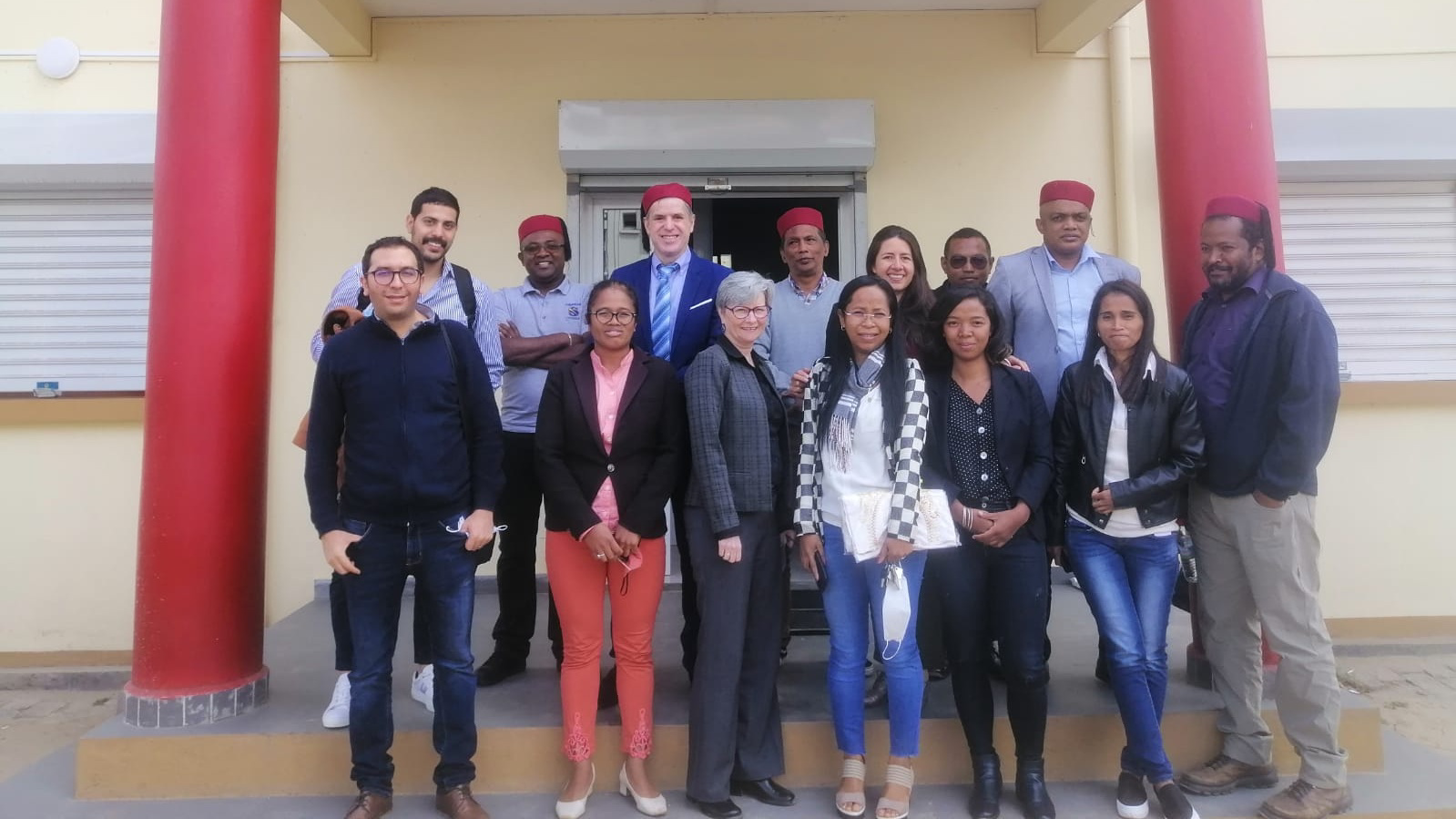"Our goal: To grow together with the bompany".

Jihen Koubaa and Sonali Parkash on their career start at tt
think tank is the first "real" employer for both of you. What was it like starting out?
Jihen: I started as a working student in 2012 after studying business administration in Tunisia and attending an eight-month German course. I started in the media editorial department of a client, but I always had a Master’s degree in mind. However, the tasks at think tank were so varied and interesting that I decided to stay. I was able to try out different areas and activities in several projects with a wide range of colleagues, from software testing and project assistance to project management and IT consulting. For me, this is one of the important advantages of a medium-sized company like think tank: you can discover a lot, a special feature at tt is that you are not tied down and can develop further.
Sona: I started during the Corona period directly after my business informatics studies. At the beginning, I was able to enjoy a bit of office time. Since I had done an internship at BMW, I was able to get directly involved in a project. This allowed me to get to know different roles and perspectives right away and thus acquire or expand my broad professional knowledge. In the process, I also discovered completely new passions. During the Corona period, we all worked remotely, of course, but the team still got along very well. When we saw each other in person after more than a year, it was as if we had known each other forever. It was important for me to have a good mentor by my side who was always there for me personally and professionally. What I liked most about tt was that everything is very informal and the colleagues are understanding. Everything can be handled flexibly in coordination with the client, so I also quickly learned to work freely and independently. I was able to try out new things and was also allowed to implement my own ideas.
What is your development path like? How has think tank supported you and helped you along the way?
Sona: In the beginning, I mainly worked on projects. Now I have a clearly structured development path with annual interviews. However, this path is not fixed, it can also be adapted through short official channels if I justify the changes well and, of course, it they are in the interests of the company. Personally, I don’t want to commit to one role, I want to remain broadly applicable, which is supported by tt. My primary goal is to continue my training as an agile coach, but I would like to remain operationally active. I am supported on my way by my team leader and my mentor. They are always available for questions, and when it comes to specialist topics, I can turn to the experts from the departments.
Jihen: There is always a tandem partner in the areas you work in that you can always ask. The hierarchies are flat and I have worked in various projects and thus acquired a broad range of expertise. I also always had the chance to further my education in training courses and thus take on more tasks. You always get support from the team leader or, earlier, from the division manager and, of course, from the HR department when it comes to further development. Personal preferences are taken into account.
What makes working at think tank special for you?
Jihen: We can express our opinions and they are taken seriously. We treat each other with respect. The work-life balance is great, there is always understanding, which is very important for me as a mother with a small child. The possibility to work remotely and to arrange my work flexibly in consultation with clients and colleagues gives me a lot of freedom. I also like the fact that you can develop and implement your own ideas. But that requires a lot of initiative.
Sona: The management always accommodates me when it comes to implementing my preferences. The self-organised work gives me the freedom that is important to me. Many colleagues have become friends. That way I have fun at work and can master everything. We also transfer this to the clients. We form a team with the clients and tackle everything together. We take the client by the hand, if necessary, and accompany him from start to finish and don’t leave him out in the cold at any point. It is important, however, that you are also proactive and that you think about and commit to your own development.
You already have experience through internships etc. with other employers. Are there any differences and if so which ones?
Jihen: I have only done internships. At think tank, I have gradually been given more responsibility in line with my individual development. What’s important for me is that I got to know the working cultures in Tunisia and Germany. That way I can sometimes build a bridge and get more involved.
Sona: I got to know the difference between a corporation and a small, medium-sized company. The hierarchies are much flatter, of course. There are also fewer employees. That’s why I don’t feel like a small “cog”. At think tank, I have had more responsibility from the start and my decisions have a greater impact than in a company. In return, I also have more influence and must and may actively participate.
What do you particularly like about your work, in terms of content and personally?
Jihen: I like the fact that I can control my work and make many decisions independently, sometimes I just work as a team member and sometimes I take over the project management for our projects. I also like the fact that I now work as a tandem partner or mentor for new colleagues, that I can pass on the knowledge I have gained and that I learn something new myself at the same time. I also experience a lot of appreciation at think tank; we all meet as equals. I appreciate a lot that we are constantly growing, which offers me new opportunities for further development.
Sona: I like that I have such different activities, that I work together in external and internal teams. The mix of operational and organisational / management topics excites me. My expertise is important and noticed and very much appreciated.
If you could wish for something, what would it be?
Jihen: I miss the on-site appointments. It would be nice if we could visit the client maybe once a quarter. It’s different to feel the atmosphere at the customer’s, it leads to new ideas and more exchange. And that we grow even more, so that I can also grow and take on other tasks.
Sona: I would like the fun to remain in the work. For me, a healthy mix of on-site and remote is important. And I also want to grow with the company.
Content:
Kanban vs Scrum? Which method leads to success?

Advantages and disadvantages of agile working methods
Those who decide to work agilely are spoilt for choice when it comes to methods. Kanban, Scrum or Lean Management are just a few of the keywords that are on everyone’s lips. Often, it is Scrum with its precisely timed sprints and user stories that those in charge choose. Whether this decision was the right one sometimes only becomes clear after a long process of trial and error. How can such a mistake be avoided?
Decision criteria for agile development methods
There is no generally valid answer to this, but some criteria can help to make a reorientation in the middle of a work process. The best way to explain this is to use a negative example in the case of a choice between Kanban and Scrum. Because it is also true in agile working that mistakes are the best teachers.
In our case, the client was faced with the challenge of organising a team that worked at different locations and whose participants did not all speak the same language. In other words, the best conditions for agile working. The task was to further develop a product that was in operation. Therefore, the choice of agile method fell on Scrum. With its clearly structured blocks, sprints and firmly outlined requirements described in user stories, this method is very popular in product development.
Adapting the agile approach
In our case, however, exactly what is otherwise an advantage became problematic: the requirements, which were precisely tailored to the team, did fit the mandate to further develop the product. In addition, however, the team had to take over the ongoing operation and support. As a result, critical defects were repeatedly added to the already existing tasks, the processing of which could not wait until the next sprint. The workload of the individual team members increased, as they felt obligated to their commitment to the user stories.
An adjustment of the method became necessary. After careful consideration, the decision was made to implement the task with Kanban. From then on, both the further development and the ongoing operation ran without further problems. But why was the Kanban method better suited than the Scrum method in this case?
Difference Scrum Kanban
It makes sense to look at the fundamental differences in the methodology of the two approaches. On the one hand we have Scrum. Here, precisely specified scopes of work are defined for a certain period of time and the progress is communicated in the daily routine. Here, it is not planned that the requirements change in the course of a sprint or that more are added, which works wonderfully well with a precisely outlined task without “disruptive factors”.
The Kanban method, on the other hand, is primarily about establishing a continuous flow of work. For this purpose, the individual work processes from the idea to the completion of the task are made visible in various so-called status columns. The starting point is usually a collection of prioritised pending issues, which are drawn up by the individual team members themselves. The ingenious thing about this is that only a certain number of tasks may be listed under the individual headings of the tables, i.e. it is not possible to start any number of new tasks before others have been completed.
Advantages of the Kanban method
This leads to tasks being completed, but unlike Scrum, it allows new requirements/ideas to be fed into the process. Of course, prioritisation of tasks and monitoring is necessary so that no “task corpses” are left on the way to completion. The product owner is responsible for monitoring the continuous process to ensure that no tasks are left undone.
Another difference is the focus of the dailies. While Scrum focuses on the team members, Kanban is more about organising the tasks and finding solutions to problems that arise.
More flexibility and faster work flow through Kanban
In our case, it became clear that Kanban had to be the method of choice because it fulfilled two requirements that were necessary for the successful implementation in the client’s sense: it was possible to feed in newly arising problems and, by focusing on the workflow, it guaranteed that both the activities that could be planned in the longer term and those that were newly added were completed.
What we have learned from this is that it is important from the beginning to examine exactly which factors play a role in the completion of a task in order to find the appropriate method. In keeping with the spirit of agility and the fault tolerance implicit in it, the courage is required to revise and reconsider a decision that has already been made if it becomes clear after the application has been launched that one has made a mistake in the choice of method.
Content:
Resilient in times of crisis: Adaptive or rather agile?

How companies can position themselves for the future
In a world characterised by crises and rapid changes, the concept of resilience is also gaining more and more importance for companies. But what does resilience mean in this context and how can the concept, which originates in psychology, be transferred to it? If you read up on the subject on the internet, two terms quickly come to mind: Adaptability and innovative learning culture.
Taking external factors into account
From these terms, it is not far to the buzzword agility. For a long time, agile working was seen as the magic bullet for making a company so crisis-proof that it could react adequately to the rapid changes so typical of our times and thus remain fit for the future. In the meantime, this way of working has lost its nimbus of being a universal remedy. What remains, however, is the need to adapt quickly to new circumstances in order to be resilient. But how can this best be achieved? This is where the topic of adaptive organisation comes into play. A one-sided perspective from which an agile way of working is introduced usually does not lead to the desired improvement. Instead, in the sense of systemic thinking, all systems, internal complexity as well as external circumstances such as competitors, market changes, wars must be considered and taken into account.
Resilient through a change of perspective
The decisive factor is therefore a change of perspective to the meta-level, i.e. a view from the outside of the company and its influencing factors. From this changed perspective, other possibilities arise and potential for improvement becomes visible. However, it is a fallacy that this potential can only ever be exploited by introducing an agile way of working. It is important to find the right means for your own organisation. Because just because a method such as design thinking was the perfect solution approach for a topic, this does not mean that this approach will be the means of choice the next time. If we return to the initial question, it can be said that agile and adaptive are not mutually exclusive; rather, agility is a building block for creating an adaptive organisation.
However, the change from a classic or agile to an adaptive organisation can only succeed if it takes into account not only the external but also the human factors such as corporate culture, communication and the employees.
Balance between structure and flexibility
It is important to develop a balance between structures and flexibility. This is the only way to create a protected framework in which new creative spaces can open up and solutions can be found. In this way, a company can change sustainably and, in the spirit of resilience, protect itself against external influences. This process is never complete. Only when an organisation continues to develop is it protected in the long term against the disruptive influences of the outside world.
The conclusion to be drawn from the question of agile or adaptive is therefore that agility is usually part of an adaptive organisation, but its methods alone are not always sufficient; companies must always keep the big picture in mind when making adjustments and changes.
Content:
"Compatibility of family and work"

Cornelia Kapl, team leader talks about the focus of her work
What are your most important career steps at think tank?
I started in 2003 as a project manager. Later, I was involved in various IT projects on site with clients and managed software development projects in the area of banking software, including testing and support. When we expanded our range of services, I also worked as a security consultant. Since 2006, I have also been a member of the company’s supervisory board. One of the most important steps for me personally, however, was the start of my work as a team leader in 2019. Initially, I was responsible for five employees, but now there are 15. The special thing about this job is that I can actively help shape the working environment of the employees and promote the compatibility of family and career. As a mother of two children, this topic is also important to me personally. I really appreciate that at think tank you can develop professionally even if you work part-time.
You've been with the same company for almost 20 years. What is the most exciting thing about your work?
Overall, I’ve always had very interesting tasks that have changed over time. I particularly value working on and with people. In the beginning, we were a start-up and of course did a lot ourselves internally, for example marketing, accounting, office management. Gradually, we were able to create jobs for the different tasks. When I look back on my career, I see that I have virtually grown with the company and also helped to shape it, which gives me a good feeling. And today, like all the other employees, I can help shape the face of think tank, because a company can only grow through its employees.
What do you see as the milestones in the history of the company?
Professionally, it is certainly the expansion from the core business of software development via IT consulting to information security consulting. The development of our own sales department, which gave us access to two large car manufacturers, was a major milestone. At that time, our third pillar, IT security, was added.
The move from Freystraße to Messerschmittstraße to more representative premises was also important. With this move, we finally left the image of the “small clit” behind us. By gaining a large real estate platform as a partner, we have further expanded our image as a reliable partner. We have built up a relationship of trust as a constant external partner and now work with 4 project owners and 18 developers together on better solutions with the client.
What makes think tank different for you?
We differ from other companies in that we pay a lot of attention to our employees. We take individual needs into consideration, employees can actively contribute. Our board members work on projects themselves, so we don’t lead from the top down, but at eye level. Everyone who works at think tank can help shape the company, every opinion is heard. You can contribute right from the start, even as an intern or junior, everyone is equal.
The development from classic to self-organisation in 2018/2019 has further strengthened these processes. We see ourselves as a self-learning organisation in which more competences and responsibilities are assigned to the employees.
We also work agilely internally on many topics, for example, we have introduced OKR as a framework for modern management and thus involve all employees in important strategic topics. The development is far from complete, our organisation is in a state of flux and this year we would like to strengthen self-organisation even further.
How do you see the future for think tank? What is important?
We are currently in the process of focusing and positioning ourselves better, making our portfolio even clearer for our clients. Our great strength is that we are very reliable and flexible. Once we have won over a client, this often develops into a long-term partnership. In addition, we know our clients’ pains and can react flexibly to them. We have succeeded in making our working methods hybrid. Our employees can work flexibly from home as well as in the office. We make up for the lack of office communication with daily joint meetings in the morning and virtual coffee chats and other joint appointments.
What are your personal goals for the next few years?
For me, the compatibility of family and career and the creation of an optimal work-life balance remains a topic close to my heart. Many of our employees work part-time without any disadvantages or being put on the sidelines, which is often the case at other companies. In addition, I would like to further my own education in order to be able to master the challenges of digital work in the future.
Content:
Neuauflage ISO 27001 kommt

What changes and what to consider
The ISO/IEC 27001 standard is not only getting a refresh and restructuring, there are also some changes to be aware of. However, all those who are already certified still have time to adjust to the changes, because the release of the new standard is not planned until the end of the year. After that, a transition period of three years is expected to apply. However, anyone planning an initial certification or introduction of an ISMS (information security management system) should do so on the basis of the updated guide, ISO 27002. This is because it has already been published since February 2022 and offers a good basis for implementation.
New title and restructuring of ISO/IEC 27002
The title of ISO 27002 is already new: From now on, it is Information Security, Cybersecurity and Data Protection – Information Security Measure. This is the standard’s reaction to the new challenges that companies are facing in the context of data security. While the old version still had fourteen subject areas and 35 measure objectives, these are now divided into the four main areas of Organisational Measures, Measures in Connection with People, Physical Measures and Technical Measures. This is to ensure better readability. In addition, the number of controls has changed from 114 to 93. This change is due to the fact that some controls have been combined. However, the new version of ISO 27002 does not contain fewer required measures, but eleven controls have been added.
Innovations and necessary steps for ISMS certification
New controls include web filtering, data masking, physical security monitoring and information deletion. But what does this mean for the re-certification or new certification of an ISMS? Especially some of the new controls, such as physical security monitoring, where it must be ensured that it is clear at all times who was in the company’s premises and when, could pose new challenges for smaller companies. How big the effort for the changeover is certainly depends as much on the size of the company as on its structures. This can only be determined after a close look at existing measures. What is certain, however, is that companies should already start analysing the gap between the existing ISMS and the one required by the new standard. Those planning an initial certification according to ISO 27001 should immediately work on the basis of the new regulations in order to avoid having to adapt existing, newly implemented processes and documentation.
"My vision: creating innovations for people"

think tank founder Mohamed Chergui in an interview
When did you first think about founding your own company?
The idea came to me during my student days in Germany. At that time, a fellow student and I updated all the programmes on a company’s computers at night by going from computer to computer with a CD. That was good for earning money, of course, but we also thought about how we could do it better. That’s when we came up with the idea of networking the world together to help people do their work. That made the direction I wanted to go in clear: new technologies and IT. My diploma thesis was about how to install software once, deploy it and then use it indefinitely.
You were offered a job at a consulting firm, but you preferred to become self-employed. Why?
I wanted to realise my own ideas and work innovatively right from the start. It was also important for me to combine the two worlds of Tunisia and Germany in order to create a synergy from the different mentalities. Initially, I and my colleagues started in Tunisia and worked with partners in Germany. We first wanted to take time to strengthen the bridge to Germany and adapt the structures in both countries, and then scale the business with the resources in Tunisia. It became clear that it is important to establish a presence in Germany as a window to Europe. Think tank Business Solutions AG was then founded in December 2002.
What were the first years like?
In the first few years we were often something like the fire brigade. We were deployed wherever there was a fire, because we were set up from the beginning to be able to react quickly. In addition, we have always relied on the latest technologies. This is how we were able to convince customers like Osram and BMW of our merits and can now look back on almost 20 years of successful cooperation. Our first projects were, for example, the optimisation of the filling of ATMs as well as the reduction of returns of the Springer publishing house from 1,000,000 to 150,000 to 200,000 within one month with the help of AI.
What were tt's biggest successes in terms of innovation?
We developed an automatic news dispatcher for dpa. This was based on the first use of an XML database with keywording in Germany and was developed as part of a diploma thesis. Even today, many good ideas are generated in this way, as we still supervise three to four diploma students a year in Tunis.
We developed the first online grocery delivery service for Karstadt. However, we were ahead of time and it was not accepted by the customers. It was important for us to be able to expand our expertise in web applications. At Osram, we implemented the first digital asset management for video and image management back in 2002, which we still maintain. In the health sector, we helped to develop the health card.
To date, we also have a wealth of experience in banking finance, ranging from online transaction processing to risk analysis regarding money laundering. We have been supporting PlanetHome as a full-service provider in the field of real estate since 2011, and together we are developing a platform on which both real estate agents and prospective buyers can take care of everything related to the purchase of a house or flat.
In the automotive industry, we are broadly positioned, from the development of an electronic calculation model to the conception and implementation of a tool for testing car parts to collaboration on an application for agile process planning.
You mention the topic of agile here. For some years now, the think tank has been increasingly focusing on agility. What is agility for you?
Developing something is very difficult because you have to react quickly. We realised pretty soon that we had to coordinate at short intervals. To do this, we set ourselves internal deliveries every week, which were reviewed by the quality assurance team the following week. So basically we were already working agile there without calling it that. The change to an agile organisation was therefore only the logical step for me on the path of digitalisation, which we have been following for a long time.
How do you see yourself as a boss?
For me, it is important to have connections, to work with people. The basic prerequisite for this is trust. I trust my team and let them decide a lot for themselves, because teamwork is very important to me. I don’t like prohibitions and I believe in flat hierarchies. The worst thing for me is when I influence someone to change. Everyone should be able to develop as they wish. First of all, there is no “must” with me, you can talk and discuss about everything.
What do you see in the staff?
Every person is special and the most important thing for me is that I perceive and value everyone as a person. I find it’s best to let people run themselves. That way I can learn from their experiences and their knowledge. Because everyone is innovative and can contribute in this way. That way, everyone benefits and a sense of “we” can develop. For me, think tank is much more than just a job; my employees are like a family to me.
What is your personal vision for the future?
I would like think tank to continue to establish itself as a think tank and contribute to simplifying people’s lives, bringing people closer together with the technologies that are available to us.
Content:
Agile transformation begins in the mind

The six biggest prejudices about agility
The topic of agility and agile transformation has arrived at most companies as an alternative to traditional work processes. But to this day, some misconceptions stubbornly persist among both proponents and critics of agile working.
Agility is chaotic
Until today, many decision-makers in companies believe that working agile means that there are no fixed responsibilities. The result is organisational chaos that no one can keep track of. In reality, however, there are requirements that have to be met even in agile working. What is not specified is how these are to be implemented. The responsibility for this lies with the team. The advantage is that there is no basis for assigning blame and the focus is on solving the problem.
If I use agile methods, I am agile
Another misconception is that it is already enough to introduce agile methods such as Scrum or a Kanban Board in order to benefit from the advantages of agile working. But there is much more to agility. A prerequisite for the successful implementation of the agile transformation is that it is incorporated into the company’s goals. Only in this way a corresponding agile mindset can develop among the employees and the company management.
Agility only works for software development and start-ups
If you start from this premise, it is also quickly clear that agile project management works in many areas. After all, agility is a matter of mentality and means above all that all employees are willing to take responsibility and to design and adapt their processes themselves according to the tasks to be solved require. This enables companies to react better to the ever faster changing circumstances.
Agile working is the answer to everything
Conversely, this does not mean that agile working makes sense for every company or every task. If the existing structures and processes work well, there is no reason per se to adapt them, as change causes unrest and must be accompanied. A regular review of the existing organisation always makes sense, because as the Corona pandemic showed, circumstances can change quickly.
Agile transformation is done in three months
The experience with the pandemic and the necessary adjustments associated with it have shown that change takes time. The same is even more true when introducing the agile way of working. Not only do the processes have to be adapted, but the entire corporate culture has to be changed. The transformation towards agile working is an ongoing process in which the narrative that exists in every company has to be reworked and developed.
Agility no longer needs leadership
The last misconception closes the circle. Because of course agile organisations need leadership. However, the understanding of a leader is different. He or she is part of the team and becomes a coach, creating the framework conditions so that the team members can carry out their work as undisturbed as possible. Important here is communication at eye level and a pronounced tolerance for mistakes.
If one takes a closer look at these prejudices, several conclusions can be drawn: Firstly: every company should check for itself whether and to what extent agile working makes sense for its own goals. Secondly, anyone who decides in favour of agile transformation should be aware that, in addition to the external structures, the attitude of the employees must also change. Because agility begins in the mind. That’s why the agile transformation needs time and often support from outside.
Content:
More investments through simplified lending

Government of Madagascar commissions think tank
Workshops and meetings to plan the project
A delegation from think tank Business Solutions flew to Madagascar with a finished concept and UX design. In four full-day workshops with the various partners, all details for the implementation were clarified. In addition, the project staff from all organisations were able to get to know each other in this way in order to clarify roles and responsibilities and to ensure that the project runs even more smoothly. In addition, further meetings were held with payment providers to guarantee the connection to the interfaces with the other platforms such as payment solutions, electronic signature and with the RCS-CM trade registry of Madagascar. A highlight of the trip was the signing of the official project contract by Mrs. Micheline Hery Manantenasoa, Head/President of PIFM and Yassine Kaaniche of think tank and with the local IT partner IBONIA. IBONIA is to support think tank on site, organise appointments and provide all necessary information for the project. After the go-live, it is planned that IBONIA will support the tt team with training and support.
Project members and go-live
In total, five major organisations belong to the project team besides tt: the International Finance Corporation (IFC), part of the World Bank Group, PIFM (Project d’Inclusion Financière de Madagascar), RNCS (Ministry of Justice of Madagascar), UGD (Unité de Gouvernance Digitale), EDBM (Economic Development Board of Madagascar) and tt’s local partner IBONIA. After the successful kick-off meeting, nothing now stands in the way of the go-live on 3 November this year.
Why is digitalisation so slow in Germany?

Background, causes and solutions
Corona has provided a digitalisation boost in some areas, but overall Germany continues to lag behind in digitalisation. In a study by the Berlin-based European Center for Digital Competitiveness (ECDC), Germany only ranked 17th among the digital upstarts of the G20 countries. Why is Germany having such a hard time with digitalisation?
What does digitalisation mean: a clarification of terms
First of all, a clarification of terms: what exactly is meant by digitalisation? Digitalisation affects everyone in society, but especially the economy. Here we speak of digital transformation or digital change. It refers to changes in processes, forms of work, customer interactions, products, services and complete business models. For example, during the Corona crisis, communication was moved to online platforms or companies are developing apps to offer their services there as well.
Front-runner and tail-runner in digitalisation
Looking at these examples, it is not surprising that there are large fluctuations in the state of digitalisation in Germany, both among the sectors and among the company sizes. Overall, however, an upward trend can be seen in most sectors and company types. The frontrunners in terms of sectors are the information and communications industry, followed by the automotive and mechanical engineering industries and business-related service providers. In terms of company size, companies with more than 250 employees are ahead with a digitisation index of 205.2. The value for medium-sized companies declined (125.4 to 119.4), and companies with 1 – 49 employees were able to increase their degree of digitalisation, but still only have a value of 93.9. The digitalisation index is based on 50 indicators such as the digitalisation of processes or human capital.
Ziele der digitalen Transformation
Klar ist jedoch, dass die Notwendigkeit des digitalen Wandels in den Köpfen angekommen ist und dass Unternehmen begonnen haben, an ihrer Transformation zu arbeiten. So verfügen inzwischen insgesamt 83% der Unternehmen über eine Digitalisierungsstrategie. Allerdings gibt ein Drittel der Befragten immer noch an, keine zentrale Strategie für die Digitalisierung zu haben, was sich langfristig auf die Erfolgschancen der Unternehmen auswirken kann. Hauptmotive für die Digitalisierung sind laut einer Studie der DIHK unter etwa 3500 Unternehmen vor allem die strategische Unternehmensentwicklung und Effizienzsteigerungen durch Kostensenkung (jeweils 57 Prozent). Auf Platz zwei liegt die Erhöhung der Kundenbindung (53 Prozent), gefolgt von der Flexibilisierung der Unternehmensprozesse bzw. Workflows (52 Prozent).
Goals of the digital transformation
What is clear, however, is that the need for digital transformation has entered people’s minds and that companies have begun to work on their transformation. Thus, a total of 83% of companies now have a digitalisation strategy. However, one third of respondents still say they do not have a central strategy for digitalisation, which can have an impact on companies’ chances of success in the long term. The main motives for digitalisation, according to a study of around 3,500 companies by the DIHK, are above all strategic corporate development and efficiency increases through cost reduction (57 percent each). In second place is increasing customer loyalty (53 percent), followed by making company processes or workflows more flexible (52 percent).
Main reasons for problems with digitalisation
There are many reasons why digitalisation projects fail or are not tackled at all. According to a survey by the DIHK, small and medium-sized enterprises in particular shy away from the high investment costs. In the first place, however, is the complexity that companies see in the implementation inot existing systems and processes. Of course, human capital also plays a role here. As in the case of the digitalisation index, it can be seen here again that the know-how for the conversion of processes or business models is lacking in the companies and must be purchased or created through further training measures. A study by the d.velop blog looks at other reasons for the failure of many a digitalisation project. The respondents see a major issue in the fact that digitalisation affects every company differently and a clear definition of requirements across all departments and areas of the company is difficult. A good third also stated that they have methodological implementation problems because they are not familiar with the agile way of working, which is important for change, and therefore do not succeed in the transition.
Possible solutions: Use of consultants and nearshoring
As is so often the case, it is difficult to change and make a transition on your own. Especially in the area of digitalisation and agility, it therefore makes sense to hire external consultants and thus buy in the missing know-how. With expert eyes and the necessary distance, they can achieve what internal employees can almost only fail at: a precise analysis of the current situation with a roadmap on how companies can use digitalisation for themselves and gradually adapt their processes. In training and coaching sessions, employees can learn new agile ways of working and adjust their mindset, which is necessary for this new form of collaboration. In order to avoid a cost explosion when adapting processes that require a new technological solution, outsourcing IT projects to nearshoring partners is a good alternative, as communication is guaranteed here due to a common working language and similar mentality . We offer a full service solution in this area. Do you have any questions? Contact us!
Content:
Zufriedene Mitarbeiter*innen im HomeOffice

Employee satisfaction and motivation are in focus
The Corona pandemic is turning our lives upside down and changing our working world. More and more people are working from home, and politicians are recommending that home offices be made possible wherever possible. Three years ago, only four per cent of employees worked in a home office; currently it is about 40 to 45 per cent. For the next three years, it is expected that about one in three will work in a home office. This is the result of the study “Flexible Work and Rewards Survey” by Willis Towers Watson. (cf. Willis Tower Watson, 2020)
What was previously a pipe dream for many has suddenly become reality. While many used to rave about the advantages (less time spent travelling from home to the office, better compatibility of work and family, more freedom in organising the day), the reality for many is not all rosy and we have to face new challenges. If the employees are no longer in the same office, many factors of employee motivation from the old world fall away. In the past, it counted in many places who had the biggest office, the fanciest company car, the freshest fruit, the newest foosball table. All that is no longer relevant. (cf. Rittershaus 2020) Now other factors count. We have to ask ourselves how we can make employees loyal, happy and motivated to work, even if they have little physical contact with the office.
We need to focus on the things that have always had the greatest influence on employee loyalty and motivation:
The right tasks
Employee-specific promotion
Real flexibility in the home office
Teamwork
and, of course, creating the technical prerequisites
(cf. Rittershaus 2020) However, the most important thing first is that the framework conditions are right.
Appreciation and respect for individual employees – our fundamental values at think tank – mean taking care of them in hard times and keeping an eye on the health of the respective employees. At the end of the lockdown, many employees come back from the home office. They worry whether they could become infected on the way to the workplace or in the office, putting colleagues at risk. Here, for us at think tank, the rule is: everyone only comes to the office if their personal situation allows it and they feel safe. (cf. t3n Digital Pioneers 2020)
Trust is the basis for successful collaboration in the HomeOffice. The mere presence of an employee has never been an indicator of performance. But this is only really noticeable in the home office. An employee in a home office works in a much more self-organised way and is responsible for his or her own actions. (cf. t3n Digital Pioneers 2020) We support this and provide a reliable start to the day, for example, with our shared daily. Through our trust-based working hours and work by objectives, we offer real flexibility in the home office.
The way of communication changes in the home office. The one-to-one communication falls away, talking across the desk no longer exists, you have to use a medium, such as MS Teams, to reach a colleague or collaborator. Enabling other types of communication is all the more important. More on this in our concrete tips, which we have been using successfully in our company since last year and are constantly developing:
Creating new frames: We go for walks together, take breaks together, Ice Breaker Dates and are open to other formats. Shared collaboration tools: We use MS Teams (formerly Skype), Jira and Confluence and Conceptboard. The combination of these tools is optimal for us to collaborate with as many senses as possible. Participation in webinars and training: This brings new momentum to the company, our employees train their own qualifications and can broaden their horizons. The newly acquired knowledge can then be shared with other colleagues in our knowledge transfers. And that in turn strengthens communication and exchange within the team. Hold joint events such as bi-weekly knowledge transfers: We meet every fortnight and share new methods and tools. Individual colleagues can pass on their knowledge, the rest of the team joins in the discussion and gives practical tips. (cf. Waser-Zeiss Nadine 2021, cf. Business Insider Germany 2020)
Daily Standup: we start our day every morning with a Daily Standup
1:1 Conversations: weekly or 2-weekly consultations with the manager take place.
Ice Breaker Dates: Every week, two people meet for a joint exchange – without a project, just a coffee talk.
Joint break times: Every fortnight we have a joint lunch break.
Working with OKR: We have created clear structures and orientation with OKR. It is not yet running optimally, but we want to show where we want to go and what each individual can contribute.
Joint successes: During Corona we worked together on the relaunch of our website and also strengthened teamwork in many client projects. We relied more on retrospectives to help us evolve.
- Creating new frames: We go for walks together, take breaks together, Ice Breaker Dates and are open to other formats.
- Shared collaboration tools: We use MS Teams (formerly Skype), Jira and Confluence and Conceptboard. The combination of these tools is optimal for us to collaborate with as many senses as possible.
- Participation in webinars and training: This brings new momentum to the company, our employees train their own qualifications and can broaden their horizons. The newly acquired knowledge can then be shared with other colleagues in our knowledge transfers. And that in turn strengthens communication and exchange within the team.
- Hold joint events such as bi-weekly knowledge transfers: We meet every fortnight and share new methods and tools. Individual colleagues can pass on their knowledge, the rest of the team joins in the discussion and gives practical tips. (cf. Waser-Zeiss Nadine 2021, cf. Business Insider Germany 2020)
After all the challenges, is working on site after Corona the way to go again? From our point of view, no. We will continue to work consistently for our employees after the pandemic and find the appropriate tasks to optimally promote and challenge them. After all, our employees are our most valuable asset. Only with motivated employees can we be successful as a company in the long term.
Sources: Business Insider Deutschland, 2020: Motivationslos durch Home Office auf Dauer
Rittershaus, Axel (2020): Mitarbeiterbindung im Home-Office [21.03.2021]
t3n Digital Pioneers (2020): Führen im Homeoffice: Diese Expertin verrät größte Schwachstellen
https://t3n.de/news/fuehren-im-homeoffice-1265295 [21.03.2021]
Waser-Zeiss Nadine (2021): Hilfreiche Tipps fürs Hybrid-Office, wenn Gemeinschaft und Zusammenarbeit besonders im Fokus liegen https://www.teamecho.com/wp-content/uploads/2021/01/Tipps-Hybrid-Office-Collaborative.pdf [21.03.2021]
Willis Tower Watson, 2020: Flexible Work and Rewards Survey: 2021 Design and Budget Priorities [21.03.2021]